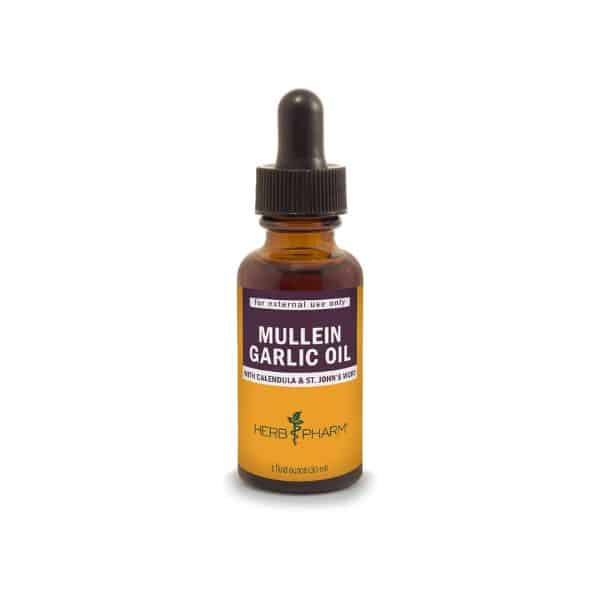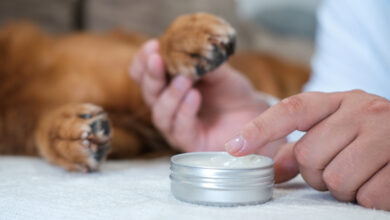Is There A Safe Home Remedy For Dog Ear Infection? Yes—Here’s What to Know
When you purchase through links on our site, we may earn a commission. Here’s how it works.
Your dog’s ears may look fine… until they’re not. One day, it’s a harmless scratch; the next, it’s pain, infection, and a risk to their hearing.
Table of Contents
That constant head shaking? The foul smell? The whimpers when you touch their ear? These are warning signs you can’t afford to ignore.
Dog ear infections can escalate quickly, from outer irritation to deep, dangerous complications. Some mild cases can be safely managed at home with the right natural remedies. Others demand fast action before the damage becomes permanent.
In this guide, you’ll learn how to spot the early signs, the real causes behind recurring infections, and the safe, natural remedies that have helped countless dog parents bring relief. You’ll also discover what not to put in your dog’s ears, how to clean them properly, and the simple habits that can prevent infections for good.
Whether your pup is battling chronic ear issues or you’re searching for a trusted home solution, this is where it starts. Let’s protect those ears before a small issue turns into something serious.

What Is a Dog Ear Infection? (Otitis Explained Simply)
Dog ear infections are more than just a minor annoyance; they can quickly become painful, persistent, and even dangerous if left untreated.
The medical term for an ear infection is otitis, which means inflammation of the ear. This inflammation can be triggered by bacteria, yeast, allergies, moisture, foreign objects, or even a buildup of wax. When the delicate tissues inside your dog’s ears become inflamed, they trap heat and moisture, creating a perfect storm for infection to grow.
While some infections are mild and treatable at home, others can escalate quickly. That’s why it’s essential to understand the different types of ear infections and what causes them in the first place.
Types of Dog Ear Infections: Outer, Middle & Inner
There are three main types of ear infections in dogs, and knowing the difference is crucial for safe treatment:
- Otitis Externa (Outer Ear Infection): This is the most common type of ear infection, and it occurs when the external part of the ear canal becomes inflamed. Thankfully, this is the visible part of the ear, making it easier to identify inflammation. But if left untreated, it can progress to otitis media. According to Merck Animal Health (Veterinary Manual), up to 1 in 7 dogs will experience otitis externa in their lifetime.
- Otitis Media (Middle Ear Infection): The next most common ear infection in dogs is caused by untreated otitis externa, which has progressed further into the canal. Another cause is when the eardrum is penetrated by a foreign object, like a grass seed or foxtail.
- Otitis Interna (Inner Ear Infection): An ear infection in the inner ear canal is called otitis interna, the final stage of an ear infection. Otitis interna is the most severe infection and can lead to loss of balance, hearing loss, and brain inflammation, which can also affect eyesight, neurological problems, and facial paralysis.
If you suspect your dog has an ear infection for the first time or it happens rarely, you should visit your veterinarian for a consultation. They must identify the cause and severity of the infection to treat your dog’s ear effectively. You should never treat a dog’s ear infection at home without consulting your vet first, as you could make it worse.
What Causes Dog Ear Infections? (From Yeast to Allergies)
Understanding the underlying causes of ear infections is essential to both treating and preventing them. While some infections are triggered by environmental factors, others result from chronic health issues, anatomical traits, or poor ear hygiene.
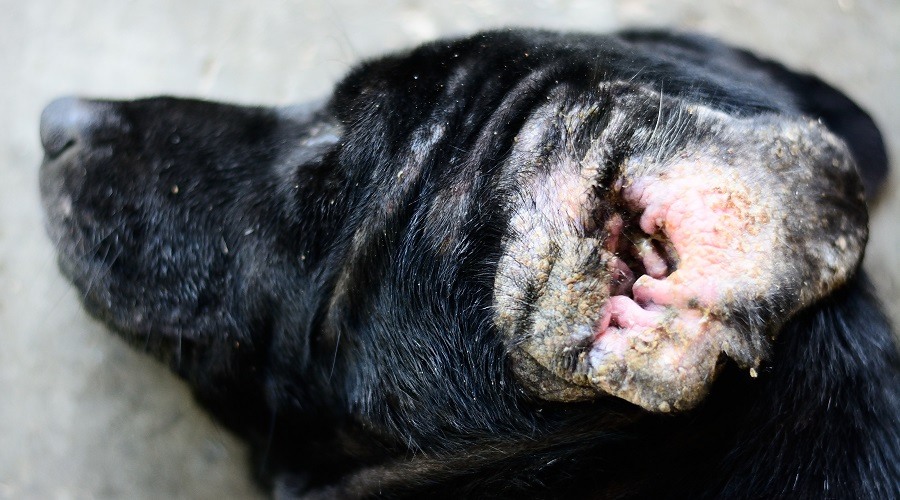
Primary Causes of Ear Infections in Dogs
- Bacterial or yeast overgrowth: Moisture and warmth in the ear canal create ideal conditions for microbes to thrive.
- Wax buildup: Excess wax traps debris and microorganisms in the ear, increasing the risk of infection.
- Foreign objects: Grass seeds, dirt, or sand lodged in the ear canal can cause irritation and secondary infection.
- Ear mites: Tiny parasites more common in puppies that cause intense itching and inflammation.
- Allergies: Environmental or food allergies can cause chronic inflammation in the ears, leading to infections.
- Moisture or poor ear ventilation: Especially common in floppy-eared breeds or dogs that swim regularly.
- Over-cleaning or trauma: Harsh cleaning methods can damage the inner ear lining, making it vulnerable to infection.
- Underlying health conditions: Dogs with hypothyroidism, Cushing’s disease, or autoimmune disorders are more prone to infections.
According to the American Veterinary Medical Association (AVMA), research suggests that dogs with long, narrow ear structures are more likely to experience ear infections than those with erect ears. Certain breeds, including Cocker Spaniels, Poodles, and German Shepherd Dogs, are the most commonly affected. Dogs that enter the water more often are also more likely to experience ear infections.
Why Identifying the Cause Matters
Treating symptoms without addressing the underlying cause often leads to recurrence. If, for example, allergies are the root issue, no amount of cleaning or home treatment will prevent reinfection until the allergy is managed.
If your dog has frequent or chronic ear issues, a veterinarian can help diagnose the specific cause through ear cytology, allergy testing, or other diagnostics.
Common Symptoms of Dog Ear Infections
Recognizing the early signs of an ear infection can prevent discomfort and complications. While symptoms vary depending on the type and severity of the infection, many dogs will display a combination of the following:
- Frequent head shaking or tilting: A common response to discomfort inside the ear.
- Scratching or pawing at the ears: Dogs may attempt to relieve irritation caused by inflammation or infection.
- Redness or swelling in and around the ear canal: Inflammation is a key indicator of otitis externa (outer ear infection).
- Unusual odor: A strong, musty, yeasty, or sour smell may indicate a bacterial or yeast infection.
- Visible discharge: Can appear brown, yellow, bloody, or waxy, depending on the cause of the infection.
- Crusting or scabbing around the ear: Often a sign of chronic infection or persistent scratching.
- Pain or sensitivity: Your dog may flinch, whine, or pull away when the ear is touched.
- Hearing changes or unresponsiveness to sound: A possible sign that the infection has progressed deeper into the ear canal.
- Changes in behavior: Increased irritability, restlessness, or lethargy may occur due to discomfort.
These signs typically appear with outer ear infections but may also be present as the infection progresses. Early intervention, especially during the first 24–48 hours of symptoms, can reduce the risk of more serious complications.
Did You Know?
Pet insurance covers the vet exam and treatment for ear infections, including antibiotics. And because ear infections are curable, some insurers cover them even if your dog has been diagnosed with one before the policy’s effective date. Pet insurance is a great idea if your dog suffers from chronic ear infections, as it can help cover the treatment costs and other health conditions.
When You Must See a Vet (8 Red Flag Symptoms)
While some mild ear issues can be managed at home under guidance, certain symptoms indicate the need for immediate veterinary care. These include:
- Loss of balance or coordination: May suggest the infection has reached the middle or inner ear.
- Persistent head tilt or circling behavior: Often linked to otitis media or interna.
- Vomiting, nausea, or abnormal eye movement: Signs of deeper neurological involvement.
- Facial drooping or muscle weakness: A potential result of inner ear inflammation affecting nearby nerves.
- Bleeding from the ear canal: Indicates trauma or a serious underlying issue.
- Severe swelling, redness, or discharge that worsens rapidly: Suggests aggressive infection or abscess formation.
- Lack of improvement after 2–3 days of home care: A sign that the chosen remedy may not be appropriate or the infection is more severe.
- Ear infection in a puppy or immunocompromised dog: These dogs require closer monitoring and professional assessment.
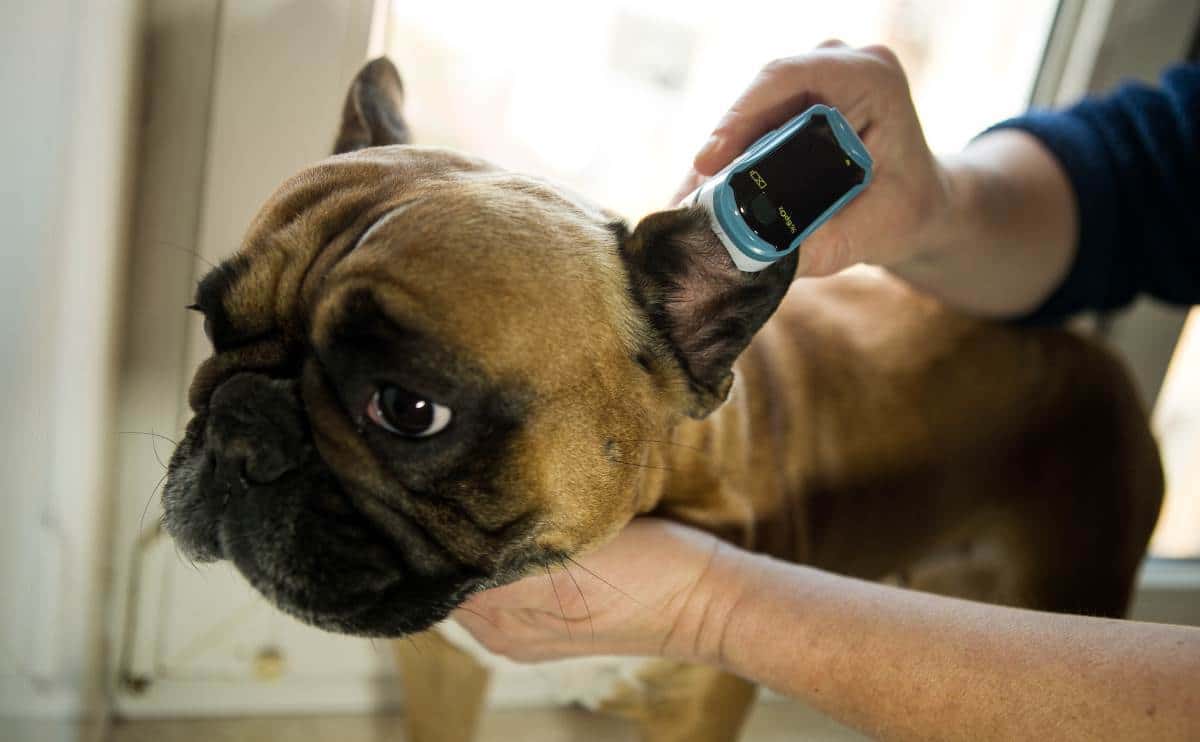
Additionally, consult your veterinarian if:
- This is your dog’s first ear infection
- The infection has occurred repeatedly in the past
- Your dog has known allergies, endocrine disorders, or chronic skin conditions
Prompt professional treatment helps avoid serious complications such as permanent hearing loss, neurological damage, or inner ear disease. In severe cases, your pup might need antibiotics for their ear infection. It’s important to do this before the infection spreads further into the ear canal.
Ear infections rarely clear up without intervention. Not only might your dog develop a more severe infection that’s harder to treat, but it could also permanently damage their hearing and quality of life.
Top 4 Natural Home Remedies for Mild Dog Ear Infections
You can offer a few natural remedies for dog ear infections at home. Some of these ingredients might be in your cupboard. If not, you can purchase all these ingredients at your local drug or grocery store.
There are lots of home remedy ideas floating around online, but not all are safe for your pooch. Always research and consider your dog’s individual needs. But after lots of research, here are the most effective, tried and tested, safe options.
1. Apple Cider Vinegar
For mild outer ear irritation and yeast overgrowth.
There’s a lot of conflicting information online about whether you can use apple cider vinegar to treat ear infections. But many vets state that you can use apple cider vinegar (ACV) to clean dog ears. Not only does it cleanse the area, but it also has antifungal and antibacterial properties.
What It Does
Apple cider vinegar is a natural cleanser with antibacterial and antifungal properties. When properly diluted, it may help reduce yeast overgrowth and soothe mild inflammation in the outer ear canal.
How to Use It
- Mix 1 part raw, unfiltered apple cider vinegar with 1 part distilled or cooled boiled water.
- Soak a clean cotton ball or gauze pad in the solution.
- Gently wipe the inside of your dog’s outer ear only — never insert anything deep into the ear canal.
- Use once daily for up to three days, or as advised by your veterinarian.
- Monitor your dog closely and stop use if any irritation occurs.
Important Safety Notes
- Never use undiluted apple cider vinegar — it is too acidic and may worsen irritation or damage tissue.
- Do not apply if the ear is bleeding, ulcerated, or if your dog shows signs of pain or sensitivity.
- Avoid use if your dog has a history of a ruptured eardrum or if symptoms suggest a deeper infection (such as loss of balance or constant head tilt).
- Always consult your veterinarian before beginning treatment, especially if this is your dog’s first ear infection or if symptoms are severe.
If you’re looking for a dog ear yeast infection home remedy, head to our yeast infection guide for prevention tips and advice.
2. Green Tea
For soothing mild inflammation in the outer ear.
If you’re looking for a gentle, natural way to calm mild irritation in your dog’s ears, green tea can be a simple and soothing option. Its natural anti-inflammatory properties make it well-suited for early-stage discomfort, especially when no signs of infection are present.

What It Does
Green tea contains natural antioxidants and tannins that may help reduce inflammation and soothe irritated tissue. When used as a gentle rinse, cooled green tea can provide relief for dogs with mild outer ear discomfort, especially when caused by allergies or yeast buildup.
This remedy is best suited for early-stage irritation where no signs of infection (e.g., discharge, swelling, strong odor) are present.
How to Use It
- Boil 1 cup of water and steep 2 bags of plain green tea (no added flavorings or caffeine) for 5–10 minutes.
- Let the tea cool completely to room temperature.
- Soak a clean cotton ball or gauze pad in the cooled tea.
- Gently wipe the outer ear flap and the entrance to the ear canal.
- Use once daily for up to 3 days or as recommended by your veterinarian.
Important Safety Notes
- Use only plain, unsweetened green tea — avoid teas with added oils, herbs, or sweeteners.
- Do not pour liquid directly into the ear canal — use a dampened pad to clean the visible outer area.
- Avoid use if your dog’s ear is bleeding, raw, or shows signs of a deeper infection (e.g., head tilt, balance issues).
- Green tea is not a substitute for antibiotic or antifungal treatment in moderate to severe infections.
- Always consult your vet before use, especially if this is your dog’s first time experiencing ear problems.
3. Mullein And Garlic Oil
For mild bacterial or fungal ear infections with vet approval.
Holistic veterinarians recommend using a garlic-and-mullein oil mixture to soothe and treat mild ear infections in dogs.
You can purchase a ready-made mixture made from organic herbs such as Herb Pharm’s Mullein Garlic Oil. It is also relatively simple to make your own natural remedy for dog ear infections.
What It Does
Mullein and garlic have been used in herbal medicine for their natural antimicrobial, antifungal, and anti-inflammatory properties. When steeped together in oil, this remedy may help soothe irritation and support recovery in mild, early-stage outer ear infections.
Garlic contains compounds like allicin, known for their antibacterial and antiviral activity, while mullein is traditionally used to ease inflammation and pain.
How to Use It
- Use a store-bought mullein and garlic oil blend made specifically for pets, or prepare a small batch at home.
- If making it yourself:
- Finely chop 3 fresh garlic cloves.
- Combine with 1/4 cup dried mullein flowers in a small saucepan.
- Add enough olive oil to cover the herbs.
- Heat gently over very low heat for 3–4 hours.
- Strain through cheesecloth and let it cool.
- Store in the refrigerator and discard after 4 days.
- Allow the oil to reach room temperature before use.
- Place 2–3 drops into the outer ear canal using a sterile dropper.
- Gently massage the base of the ear to distribute.
- Apply once daily for a few days, if tolerated, and monitor for changes.
Important Safety Notes
- Do not use this remedy if your dog’s ear is bleeding, severely inflamed, or visibly damaged.
- Never use oil-based remedies if your dog has a ruptured eardrum or signs of a deeper infection (e.g., balance issues, head tilt).
- Homemade garlic oil can grow botulism-causing bacteria if stored improperly. Always refrigerate and discard after 4 days.
- Consult your vet before using this remedy, especially for the first time or if your dog has a history of ear infections or skin sensitivities.
To prevent the risk of botulism, the Centers for Disease Control and Prevention recommends refrigerating all homemade garlic and herb oils and discarding them after four days.
4. Oregano Oil
For targeted antimicrobial support, use with caution and vet approval.
If you’re dealing with a recurring or hard-to-treat ear infection, oregano oil may offer additional support, but it must be used with caution. This remedy is powerful and should be considered only in diluted form, under the guidance of a veterinarian.

What It Does
Oregano oil contains two powerful compounds, carvacrol and thymol, known for their antibacterial, antifungal, and anti-inflammatory effects. Research from Veterinary Dermatology, an online peer journal, shows they are effective against known antibiotic-resistant bacterial strains in canines with otitis externa.
How to Use It
- Choose pure oregano essential oil (Origanum vulgare) and a safe carrier oil such as olive oil, coconut oil, or aloe vera juice.
- Mix 1 drop of oregano oil with 1/2 ounce (1 tablespoon) of carrier oil.
- Test a small amount on your dog’s skin to check for any reaction before applying near the ear.
- Using a clean cotton pad, gently wipe the outer ear flap with the diluted solution — do not drop directly into the ear canal.
- Apply once daily for up to 3 days, watching closely for any signs of irritation.
Important Safety Notes
- Never use undiluted oregano oil on your dog — it can cause severe irritation or chemical burns.
- Do not apply inside the ear canal or on inflamed, raw, or bleeding tissue.
- Avoid use if your dog shows signs of a deeper infection (e.g., head tilt, balance issues, strong odor, or discharge).
- Dogs with sensitive skin or underlying allergies may react to even diluted oregano oil.
- Always consult your veterinarian before using oregano oil, especially if your dog has chronic or recurring infections.
How Long Do Home Remedies Take to Work? (What to Expect)
The time it takes for home remedies to work depends on several factors — including the cause of the infection, the severity of symptoms, and whether you’re addressing the underlying issue (like allergies or moisture buildup).
In general:
- Mild irritation may improve within 1 to 2 days with a safe, diluted remedy such as green tea or apple cider vinegar.
- Mild infections could take 3 to 7 days to resolve, provided they are treated early and symptoms are closely monitored.
- If symptoms don’t begin to improve after 48–72 hours, or if they worsen, it’s important to stop home treatment and consult a veterinarian.
- Chronic or recurring infections may require long-term management and professional care.
What to Expect If It’s Working
- Reduced head shaking or scratching
- Less visible redness or swelling
- Ears appear cleaner, less waxy, and have no foul odor
- The dog is more comfortable and responsive
When It’s NOT Working
- Continued discharge, odor, or redness
- The dog is still shaking, scratching, or showing signs of pain
- New symptoms appear (loss of balance, head tilt, nausea)
- Your dog resists handling or touching around the ears
Prompt action at the first signs of worsening infection helps prevent serious complications, such as inner ear damage or permanent hearing loss.
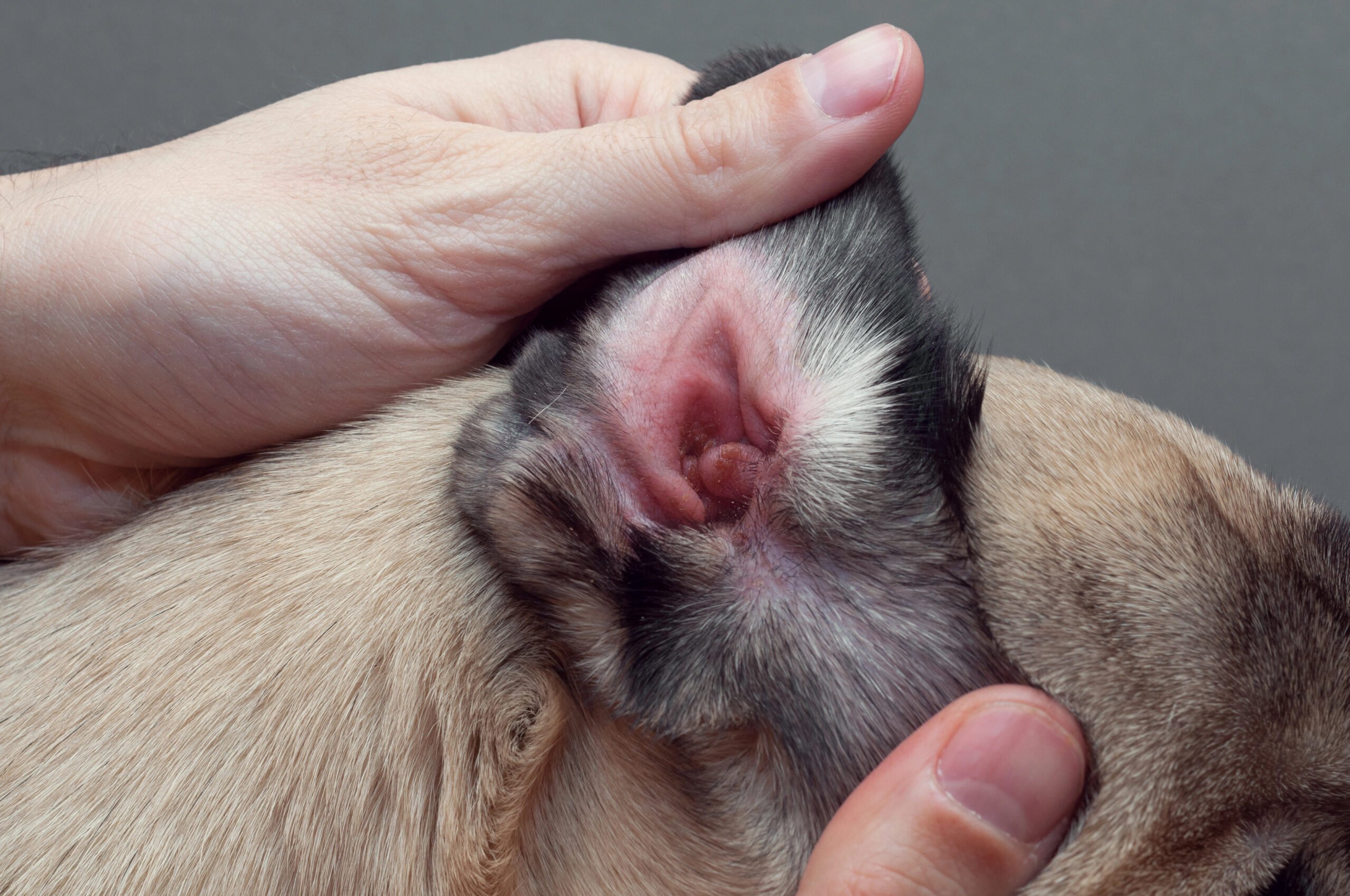
What NOT to Use on Your Dog’s Ears (And Why It’s Risky)
There are many online recommendations for ear care products that may be unsafe or harmful for dogs. These substances can cause burning, irritation, or deeper tissue damage, especially when the ears are already inflamed or infected.
Avoid Using the Following 5 Things in Your Dog’s Ears:
- Hydrogen peroxide: Harsh and potentially damaging to healthy tissue; can cause pain and delay healing.
- Rubbing alcohol: Extremely drying and irritating, especially in inflamed or ulcerated ears.
- Witch hazel: While sometimes used for minor skin irritation, it can sting and worsen inflammation inside the ear.
- Essential oils (undiluted): Potent oils like tea tree, oregano, or eucalyptus can cause burns, allergic reactions, or neurological toxicity if misused.
- Cotton swabs (Q-tips): Risk of pushing debris deeper into the ear canal or damaging the eardrum.
Using these substances may lead to pain, resistance to future ear handling, or even worsen the condition. Always consult your vet before applying anything to your dog’s ears.
Can You Use Human Ear Drops on Dogs?
No, you should not use human ear drops on dogs unless specifically directed by a veterinarian.
Human ear medications are designed for human ear anatomy and pH, and often contain active ingredients that may be toxic or irritating to dogs. Some products contain alcohols, preservatives, or pain relievers that are not safe for canine use.
Even if the symptoms appear similar, dog ear infections are often caused by different types of bacteria, yeast, or mites and require a treatment plan tailored to your pet’s specific condition.
If you suspect your dog needs medicated drops, consult your vet. They can prescribe a product formulated specifically for dogs and safe for their ears.
Choosing the Right Home Ear Infection Remedy for Your Dog
Not every home remedy is right for every dog. The best approach depends on the type of symptoms, your dog’s history with ear infections, and whether you’ve ruled out a more serious underlying issue.
Use the guide below to help decide when a natural remedy may be appropriate — and when it’s time to stop and consult your vet.
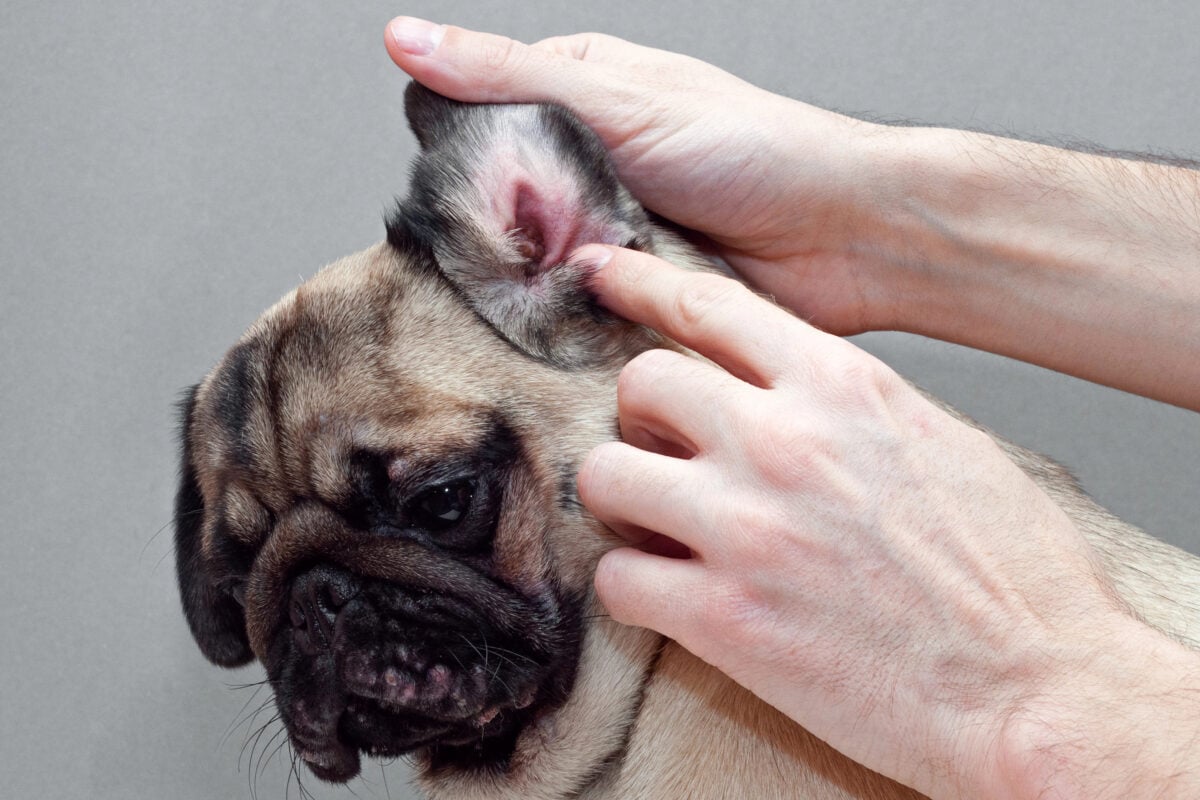
Use Home Remedies With Caution If:
- Your dog has had mild, outer ear infections in the past, and your vet has approved at-home treatment.
- Symptoms are limited to minor redness, itching, or odor with no discharge or pain.
- You are using the remedy on the outer ear only, not inside the canal.
- Your dog has no history of ear surgery, ruptured eardrums, or chronic disease.
In these situations, remedies like apple cider vinegar, green tea, or mullein and garlic oil may offer mild support — but always monitor your dog closely and stop if symptoms worsen.
Avoid Home Remedies If:
- It’s your dog’s first ear infection, or the cause hasn’t been diagnosed.
- You notice pus, blood, or foul-smelling discharge.
- Your dog is in visible pain or shows signs of a deeper infection (head tilt, unsteadiness, vomiting).
- Symptoms don’t improve after 48–72 hours of home care.
- Your dog is a puppy, a senior, or immunocompromised.
In these cases, delaying veterinary care may lead to permanent damage. A veterinarian can determine whether the infection is bacterial, fungal, parasitic, or caused by allergies — and prescribe the right treatment.
When in Doubt, Call Your Vet
Home remedies may provide relief in early-stage or mild cases, but they are not a replacement for diagnosis and medical care. If you’re ever unsure, it’s safer to get a professional opinion before applying anything to your dog’s ears.
Our Experience With Dog Ear Infection Home Remedies
Sometimes the best insights come from firsthand experience.
My dog Bear, a lovable black Labrador Retriever mix, had a long history of ear infections. After multiple rounds of antibiotics and little lasting relief, we were open to safer, more sustainable alternatives.
At our vet’s recommendation, we tried a natural approach using diluted oregano oil. I mixed a few drops with coconut oil and applied it topically. In some cases, I also gave it orally in small, vet-approved doses. To our relief, Bear responded incredibly well.
The oregano oil didn’t upset his stomach or irritate his skin, and more importantly, it helped clear up mild infections that once led to vet visits. Of course, we only used it under supervision and with clear signs that it was safe to do so.
It didn’t just offer relief. It gave us a sense of control and peace of mind.
– Danielle DeGroot, Rescue Dog Parent & Writer For Canine Journal
Preventing Future Dog Ear Infections: 7 Simple Steps That Work
While some dogs are naturally more prone to ear infections, there are simple habits that can go a long way in keeping their ears clean, dry, and infection-free.
- Dry ears after baths or swimming: Use a soft towel to gently blot moisture from the ear flap and outer ear canal.
- Clean ears regularly — but not excessively: Over-cleaning can irritate the ear lining. Use a vet-approved ear cleaner as needed based on your dog’s breed and activity level.
- Check ears weekly: Look for redness, odor, wax buildup, or debris — early detection is key.
- Trim excess ear hair: Especially in breeds with heavy ear canals. Ask your groomer or vet how to do this safely.
- Manage allergies: Chronic inflammation from food or environmental allergies is a major cause of recurring infections.
- Feed a high-quality diet: A balanced, whole-food diet supports immune health and skin resilience. Consider adding omega-3s or probiotics if recommended by your vet.
- Avoid moisture-trapping ear coverings: In hot or humid weather, keeping ears exposed helps reduce warmth and bacterial growth.
Consistent care and early attention to changes can make all the difference in preventing painful ear infections—and keeping your dog healthy, happy, and hearing clearly.
How To Clean Your Dog’s Ears
Adopting a regular ear-cleaning routine can help prevent recurring dog ear and yeast infections. Check out our guide on the best dog ear-cleaning solutions to keep your pup’s ears healthy. Cleaning your dog’s ears is relatively simple. Watch this informative video by veterinary professionals on cleaning a dog’s ears at home.
Frequently Asked Questions
Ears are delicate and complex, so we know some of our readers still have questions about ear infections and home remedies. If you can’t see your question below, please ask us in the comments section, and our team will find the answer for you.
What’s the best home remedy for a dog ear infection?
There is no best home remedy because all dogs are different. One dog might respond quickly to a DIY dog ear infection treatment at home, whereas it might not have any effect whatsoever on another pup. Once you’ve consulted with your vet about your dog’s ear problem, discuss whether a homemade remedy can help and which one they recommend.
Can dog ear infections heal on their own?
Most ear infections won’t go away without intervention. Left untreated, they can worsen and spread deeper into the ear, causing lasting damage. Even mild symptoms should be monitored and addressed early with appropriate care.
Is it safe to treat a dog’s ear infection without seeing a vet first?
Not always. While mild cases may respond to at-home care, infections that are untreated or improperly treated can become more severe. If it’s your dog’s first infection, if symptoms are worsening, or if you see discharge, pain, or balance problems, a vet visit is essential.
How often should I clean my dog’s ears to prevent infections?
This depends on your dog’s breed, activity level, and ear anatomy. In general, check and gently clean the ears weekly or after swimming or bathing. Use a vet-approved ear cleaner and avoid over-cleaning, which can irritate the ear canal.
Should I give my dog probiotics for chronic ear infections?
Probiotics may help support immune health and balance gut flora, which can indirectly reduce inflammation and allergic reactions — both of which contribute to chronic ear infections. Ask your vet if adding a canine-formulated probiotic is appropriate for your dog.

Is Your Dog’s Diet Causing Ear Infections? What to Know
A dog’s diet can heavily influence their health and well-being. Providing your dog with a high-quality diet can help keep their immune system strong and assist in fighting infections and other ailments. Alongside medication, vets often recommend a dietary upgrade for dogs with chronic ear infections.
A great place to start your research is with our dietary guide on all-natural dog foods. Alternatively, many parents opt for fresh food diets as they often contain all-natural, more premium ingredients. You can sometimes tailor their recipes to suit your dog’s dietary needs. Some pet owners see significant improvement in their dog’s ear health after transitioning to novel proteins, avoiding common allergens, or introducing anti-inflammatory supplements like omega-3s.
If your dog’s ear infections keep coming back despite treatment and prevention, it’s worth having a conversation with your vet about whether diet could be playing a role. A nutrition-based approach won’t replace medical treatment, but for many dogs, it’s the missing piece of the puzzle.
Tried a Home Remedy for Your Dog’s Ear Infection? Share Your Experience
Has your dog ditched the ear infection with one of these home remedies? Or do you have your own home remedy? We’d love to hear your thoughts and stories in our comment section below.

